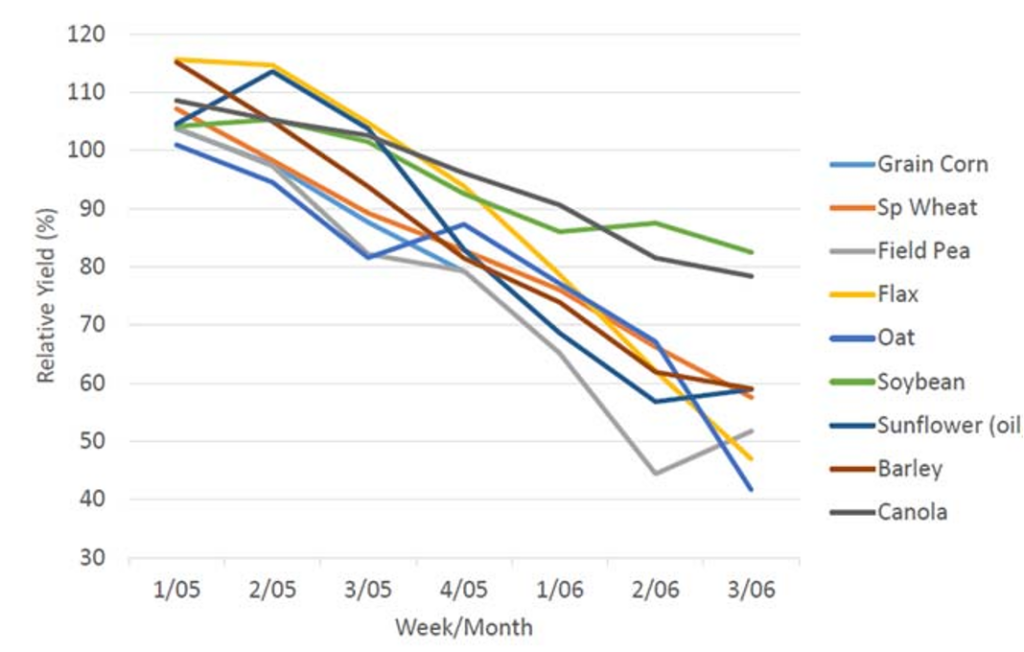Seeding Date and Seeding Rate Considerations for Spring Cereals

There are many considerations when planning spring seeding of wheat and barley. Seeding date and seeding rate are two variables to think about to get your crop off to a good start.
Seeding Date
Seeding date is an important factor to consider, as it can impact overall crop yield. In Manitoba, spring wheat and barley are usually seeded between May 1 and 30. Although, if the conditions are optimal, farmers have been able to seed in April.
- If conditions are conducive to seeding, earlier seeded (figure 1) crops tend to have higher yields and improve yield stability (Manitoba Agriculture, n.d.). Earlier seeded crops can utilize early spring moisture more efficiently, assisting in quick and vigorous growth, which helps reduce weed competition.
- Additionally, earlier seeded crops, depending on their flowering date, potentially avoid heat damage during flowering. More information about early seeding can be found here and here.

Figure 1: Seeding date vs. relative yield for common Manitoban crop types between 2010-2019 (MASC, 2019)
There are risks associated with early seeding these include:
- The risk of frost. Most spring wheat and barley are tolerant to some frost (down to -6 °C) when the growing point is below the soil surface, this is until the 5-leaf – jointing stage. Frost damage symptoms include leaves that are dark green, wilted, and have dead leaf tips (Manitoba Agriculture, n.d.). Risk of frost damage and plant death increases when the growing point gets closer to the soil surface.
- Seeding into cold and wet soils will slow crop emergence, therefore consider using a seed treatment. It should be noted that a minimum temperature of 4 °C is required for germination for wheat and barley (Manitoba Agriculture, n.d.).
Farmers know best about the typical weather conditions in their area. In addition to lived knowledge, long-term weather data can help identify the risk of frost in your area. Manitoba Agriculture produces frost maps for the province which can be found here.
Seeding Rate
The seeding rate of spring cereals is an important decision that can affect both yield and grain quality, by impacting all key wheat yield components. Seeding rates differ between crop types. Current Manitoba Agriculture recommendations for wheat and barley are found in table 1, below. Furthermore, when selecting target plant populations overall management practices, such as soil fertility or pest management, and field selection should be considered to handle the selected target plant population.
Table 1. Manitoba target plant populations recommendations for spring wheat and barley.
|
Crop |
Target plant population (plant/ft2) |
|
Spring Wheat |
23-28 |
|
Barley |
22-25 |
Manitoba Agriculture’s target plant populations were recently reevaluated in 2017 and 2018 and were found to still be adequate (Manitoba Agriculture, 2020). Yield results from the study can be found in figure 2. Plant populations also affect crop uniformity, time to maturity, lodging risk, disease risk, weed competition and overall yield stability (Manitoba Agriculture, n.d.; Collier et al., 2021). Higher seeding rates have been found to improve crop uniformity and decrease days to maturity (O’Donovan et al., 2012). Crop uniformity is also one important component to maximize the efficiency of crop protection agents, such as fungicide application for fusarium head blight. Higher seeding rates have also been found to decrease weed competition.
However, higher seeding rates may lead to thicker crop canopies, thus creating an environment more conducive to disease. As well, increased lodging, and inter-plant competition for resources can be an issue with higher seeding rates, reducing the crop yield potential. If you are planning on targeting higher plant population, it is recommended that varieties with strong straw strength or semi-dwarf varieties are used. Refer to Seed Manitoba for this information. More information about higher seeding rates, its benefits and risks can be found here.
Figure 2. Spring wheat (left) and barley (right) yields at five target plant densities from trials across Manitoba. Different letter represent statistical significant differences in yield (Manitoba Agriculture, n.d.)
Research has found that for malting barley the optimum target plant population which maximizes yield and grain quality to achieve malting grade is at the lower end of Manitoba Agriculture’s recommended target plant population (O’Donovan et al., 2012). For more information on malting barley specific seeding considerations check out this document.
Seeding by target plant population is encouraged, as seeds come in different sizes. This method accounts for differences in thousand kernel weight and per cent expected seed survival. This method allows you to optimize your seeding rate and give you the best chance to hit your target plant population. The formula can be found below. Although, seed calculators from FP Genetics and Alberta Grains can take the manual calculations out of it. More information about seeding by plant population can be found here.

*Per cent expected survival is expressed in decimal form. ex. 85 per cent = 0.85.
References
- Manitoba Agriculture. (n.d.). Reward Versus Risk: Seeding Early In Manitoba. Province of Manitoba | agriculture – Reward Versus Risk: Seeding Early in Manitoba (gov.mb.ca)
- Manitoba Agriculture. (n.d.). Spring Frost Damage. Province of Manitoba | agriculture – Spring Frost Damage (gov.mb.ca)
- Manitoba Agriculture. (n.d.). Aiming for higher wheat yields. Province of Manitoba | agriculture – Aiming for Higher Wheat Yields (gov.mb.ca)
- Manitoba Agricultural. (2020). Seeding Rates for Spring Cereals. seeding-rates-spring-cereals.pdf (gov.mb.ca)
- Collier, G.R., Spaner, D.M., Graf, R.J., & Beres, B. (2021). Optimal Agronomics Increase Grain Yield and Grain Yield Stability of Ultra-Early Wheat Seeding Systems. Agronomy. 11(2), 240. https://doi.org/10.3390/agronomy11020240
- O’Donovan, J.T., Turkington, T.K., Edney, M.J., Juskiw, P.E., Harker K.N., Clayton, G.W., Laford, G.P., Brandt, S., Johnson, E.N., May, W.E., & Smith, E. (2012). Effect of seeding date and seeding rate on malting barley production in western Canada. Canadian Journal of Plant Science. 92; 321-330. https://doi.org/10.4141/cjps2011-130


